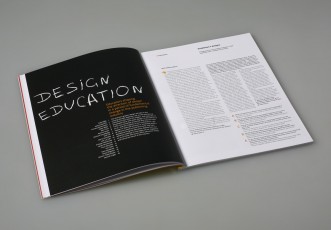Design Education, Part III: Titus Nemeth
Well-known international design instructors answer our poll about job opportunities for design graduates, the differences between academic theory and real-world practice, specialisation vs general education, and their own motivations to teach design. (This is the full version of the poll published in TYPO 43.)
Design Education
Educators shaping the direction of design in a period of fundamental change in the publishing industry
Palo Bálik, Marcel Benčík, Tomasz Bierkowski, Peter Biľak, Min Choi, Patrick Doan, Richard Doubleday, Will Hill, Gerry Leonidas, Loîc Le Gall, Kristjan Mändmaa, Jacek Mrowczyk, Titus Nemeth, Ivar Sakk, Ewa Satalecka, Silvia Sfligiotti, Martin Tiefenthaler, Gerard Unger
The direction graphic design will take in the coming decades depends a lot on the educational institutions that teach the subject, and especially on the people there who teach design. As the editors of TYPO, we constantly encounter this issue as most of us—and the majority of our contributors—are regular or featured lecturers or workshop leaders at various schools around the world. We have decided to bring the education debate from our editorial meetings to the pages of our magazine so as to foster discussion about education today, and hence the future of the industry.

Titus Nemeth, ESAD / ESAV, France / Morocco
What motivated you to decide to teach design and/or typography?
When I first taught, I was merely giving it a shot, I didn’t know what to expect. Soon enough, however, I discovered that teaching did appeal to me for a number of reasons. Discovering in practice what it meant to articulate one’s thoughts, processes and routines to a student was probably the most rewarding experience. The reflection and learning that has to go into teaching is what retains the biggest challenge and interest. The more obvious motivation of passing on knowledge and “savoir-faire” is particularly pertinent in my teaching in Morocco, where my interests, work and skills are most immediately applicable.
Can you estimate about how many graphic designers your country graduates each year? Are there job opportunities in their field?
In France there must be many hundreds if one considers all the different art schools and fine art departments. Yet I would assume that their skills and job opportunities vary quite widely, for French design education still struggles to overcome an inferiority complex toward the fine arts. Design as a discipline in its own right that does not aspire to be fine art is not yet fully embraced in the field. This is reflected in the curious notion of “infographie” (to my knowledge only existing in the francophone world), which denotes a discipline and profession whose only competence are software skills. This misunderstood notion of design and the lack of design culture with clients and agency directors alike make for an environment in which freelancers regularly provide unpaid work (in so-called “appels d’offre”) and/or work full-time hours without proper employment for salaries sometimes as little as €8/hour. In view of these circumstances, design education that provides (1) unique skills, (2) self-confidence and (3) a more international perspective are crucial for the advancement of the field in France and Morocco alike (the situation is more complex in the latter case).

Titus Nemeth’s class, Lettering excercises for the Atélier experimental Arabic type, ESAV, Marrakech, 2010
Does your school find that there is a certain gap between “the real world” and what students learn at school? If so, how do you deal with this issue?
The gap between education and professional practice is certainly there. Yet it is not always a bad thing to have a safe haven of experimentation and freedom in the context of design education that would not be tenable in the “real world”. Having said that, I feel that the policy of engaging professionals from the field as part-time lecturers, rather than having full-time teachers, is a valid and pragmatic way of overcoming this gap (though it has its specific problems too). Both schools that I lecture at emphasise this approach.
Should schools provide a universal education in graphic design, or is it important these days to specialise in specific areas and tasks?
I suppose a good case can be made for both scenarios and I would hesitate to exclude either one. The specificity of a design education very much depends on the level you are teaching at, with a post-graduate course offering more opportunities for specialisation than an undergraduate course. Generally speaking, designers today will often require a vast range of skills to be able to cater for different media — one could therefore favour a multi-disciplinary education. In the same vein, the exact opposite stance is just as valid: the field is becoming so heterogeneous that more specialised designers collaborating in loose networks might be more sustainable and realistic: you just can’t be good at everything.
Do you think it is a good idea for students to work on actual commercial contracts while they are still in school? Should the school and the instructors at the school support this?
Again, this depends very much on the case and context. Whilst it might provide a valuable learning experience, it might be pedagogically disastrous when the clients’ interference into student projects and concepts creates disillusioned and cynical middle-down-the-road-designers, rather than ingenious and unexpected design graduates. If one introduces commercial work into education, I suppose it must be directed by a teacher who stands up to his pedagogy rather than one who easily bows before the client.
| When I first taught, I was merely giving it a shot, I didn’t know what to expect. Soon enough, however, I discovered that teaching did appeal to me for a number of reasons. Discovering in practice what it meant to articulate one’s thoughts, processes and routines to a student was probably the most rewarding experience. The reflection and learning that has to go into teaching is what retains the biggest challenge and interest. The more obvious motivation of passing on knowledge and “savoir-faire” is particularly pertinent in my teaching in Morocco, where my interests, work and skills are most immediately applicable. |
Add Comment
Author’s latest articles
- By Design conference in Bratislava 11. 5. 2014
- Live from Typo Berlin 15. 5. 2013
- Download Typo for your iPad! 4. 12. 2012
- Design From Best 2012 18. 6. 2012
- Slanted issue # 17 – Cartoon / Comic 30. 4. 2012



 editors
editors

Comments (0)